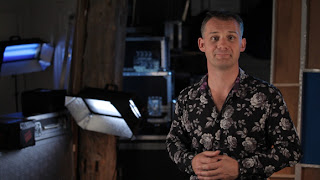 If Captain Kirk beamed down to Earth in 2011 he, and Spock, would be amazed at the amount of time modern humans spend in front of screens. Star Trek might have foretold our love of hand-held communication devices, but it didn't anticipate our craving for screens.
If Captain Kirk beamed down to Earth in 2011 he, and Spock, would be amazed at the amount of time modern humans spend in front of screens. Star Trek might have foretold our love of hand-held communication devices, but it didn't anticipate our craving for screens.Screens are everywhere: on our phones, in our pockets, our laptops and PCs, our TVs and even in our cars. We suck up hours upon hours of moving images and even produce half of them and broadcast them on YouTube.
Quality has become the Jekyll and Hyde of the 21st Century: stellar HD on our LED screens - and home-made, jerky footage shot on our iPhones and uploaded onto the web.
The cost of HD cameras that can capture broadcast quality images has plummeted. That means anyone can pick up a camera and shoot professional video - right? Well, yes, but the importance of quality has, for a while, been downgraded, and that's a bad thing.
It's especially bad for business.
Business has always been a big user of video. It's one of the best way to get a message across to all kinds of stakeholders (internal and external) and has long been used as a way of reflecting corporate values and building engagement with staff, customers and other audiences.
So, it seemed logical to put together the need for corporate video with the explosion in accessible technology and cut out the middle-man. I mean, who feels sorry for a video producer who's making less money or none at all? It's the logic of business: cut costs and deliver more value.
Simple.
But it's not simple. I recently started a discussion about video production and it's current state on LinkedIn and the response was enormous. It seems that what I like to call the 'YouTube Moment' is passing. Many people out there are beginning to realise that quality matters. Quality communicates. It always has and it always will. And I don't just mean the quality of the actual image and sound on the screen, important as they are, what really makes a difference is the quality of the service, skills and experience of the people who get those images, put them together in a compelling way, and ensure that a message is communicated.
That’s real quality.
Many respondents on LinkedIn used simple and obvious analogies: I can go out and buy plumbing equipment but it doesn't mean I'm going 'to install a quality bathroom. I can buy a good printer but it doesn't mean I have the design expertise or materials to make business cards that inspire confidence in my customers.
When you really want to do business you call in a professional who knows how to make the most of their equipment, and who has the experience to stop you making costly (and embarrassing) mistakes.
The 'YouTube Moment' hit us about five or so years ago. People began to think that because YouTube, with its amateurish videos shot on high-spec technology, was so popular it was possible to circumvent production companies and their expensive camera crews and producers and writers and so on, and do it all in-house.
Often, it back-fired. What many did was the equivalent of handing out low-quality business-cards which just served to make them look cheap.
Production companies have realised that they need to work harder to deliver quality, add greater value and persuade clients that quality from concept to screen actually counts. I think that's starting to work. For my part, I'm selling my services much more on quality of service and ideas than technical points. And it's working.
When I look back I realise that, maybe, many video production didn't engage with their clients enough. They excluded clients from the production process. That made clients believe they were paying for 'smoke-and-mirrors' rather than talent and expertise.
I think we need to be much more transparent about what we do and how we do it, and SHOW clients how we achieve quality on their behalf. The client has to be part of the creative journey, and then they will see how their cash is being spent on making them, and their products and services, look brilliant.
If you would like to chat further, please get in touch. I’m here to make you or your company look good... whichever way we do it.




